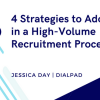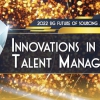Three Ways to Deal with Workforce Retention in Today’s Hyper-Uncertain Labor Market
With unemployment claims skyrocketing to almost 10 million at the end of March and expected to jump by millions more, COVID-19-driven economic jolts have quickly shifted the labor environment to the most volatile we’ve seen – well, ever.
For some employees – especially those with tenure, or high performers in essential business functions – the natural instinct will be to hunker down and weather the storm. Others, spooked by their current organization’s readiness to navigate this hyper-uncertainty (especially those with relevant and in-demand skillsets), will start exploring their options in search of more stable opportunities.
This greater openness to external job opportunities, and as a result, unsolicited recruiting messages, raises the risk of workforce turnover. And while many organizations are furloughing and laying off workers to address pandemic-related cost concerns, areas of the labor market are surprisingly still tight, making it harder to find and source talent for in-demand roles.
Talent Is Key For Navigating Chaos
Data shows 72% of an organization’s value is tied to its employees – and this link is even more imperative for maintaining business performance in tough times. No organization can afford to lose their best workers right now. Holding onto talent that may be considering leaving requires organizations to implement targeted, proactive retention programs.
The industries, locations, and job functions most at-risk according to a recent labor market analysis:
- Recruiters (115% above national volatility average), software engineers (+105%), marketers (+82%), and finance professionals (+77%), all typically categorized as highly volatile, are even more so today. Given these functions are some of the most competitive, it’s crucial to check in with these workers internally and identify and address any underlying attrition risk factors.
- Companies based in the greater San Francisco (50% above average) and Washington D.C. (+41%) areas tend to face above-average worker volatility levels. Organizations across every industry and size located in or around these cities should make retention their top priority, especially given how much this crisis will hit startups.
- Historically stable roles such as teachers (now 101% above average), skilled trades (+97%), construction (+83%) and healthcare staff (+77%), specifically nurses and doctors (+54% each), are among the most volatile considering the pandemic. This spike points to future talent risk with these workers on the frontlines of our COVID-19 response.
Strategies And Best Practices To Get Retention Right
Programs will look different for every organization given each has unique needs and objectives, but there are tried and true ways to boost retention. During these challenging times, when many companies are strapped for time and resources, it's especially important to implement very targeted strategies.
Predictive insights offer a huge advantage in finding the best candidates and attracting them with the right recruiting messages. This intelligence also enables companies to identify the risk of attrition before it manifests, and high-value talent resigns.
1. Keep your employees engaged by making them feel heard.
Over 75% of millennials – who make up the largest percentage of the workforce – feel businesses focus too much on corporate agendas, and not enough on contributing to society. While running a profitable business is important and will require even more attention in light of today’s reality, companies can’t ignore the societal implications of the pandemic and must demonstrate a commitment to the well-being of their employees and communities. On a broader scale, it’s important that employees of all generations feel heard. One of the best ways to engage, and subsequently retain, your workforce is to understand what encourages staff to perform at their best and create cultures that prioritize those motivators.
2. Foster a supportive work environment and community.
Some studies show loneliness in the workplace was already a pervasive issue before the pandemic – and the gravity of today’s situation will likely add fuel to the fire. When employees feel lonely, they’re often disengaged from their work, making them less productive, and more apt to explore new roles and company cultures. Making people feel part of a community while at work is important – especially while most are working remotely. Virtual happy hours or team lunches over video where folks order from a local restaurant can boost morale, establish a sense of community and facilitate team bonding. It’s also important to recognize employees’ contributions, increasing their overall confidence and incentivizing them to do good work not only in the interest of the business but also for their own satisfaction and motivation.
3. Tell them what they need to hear.
Employees jump jobs for a variety of different reasons, but today, fears over job security, company resiliency and business stability top the list. When employees feel they could lose their jobs or career momentum, they’re more apt to explore other opportunities that will fuel their professional development. Employers need to understand the workplace characteristics their employees value and prioritize them accordingly. Today, for example, employees are putting more weight behind company resiliency (up 12% from December) followed by business stability, which means reassuring staff of the company’s performance and financial health in this challenging time, and clearly communicating what you’re doing from a resiliency perspective, is key.
While undoubtedly more difficult today, with the right best practices, strategies, and market intelligence, employers can still source and sustain a reliable talent pipeline to thrive despite the uncertain employment environment.







